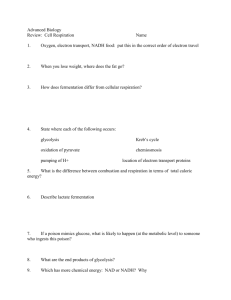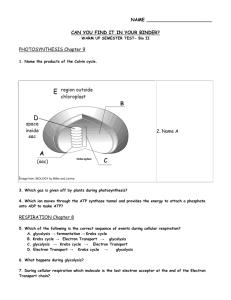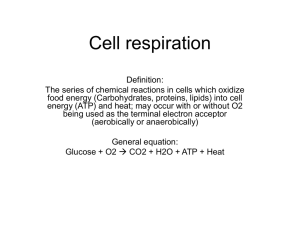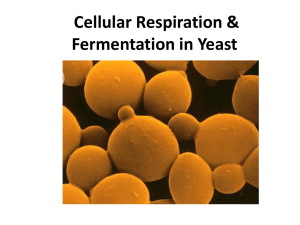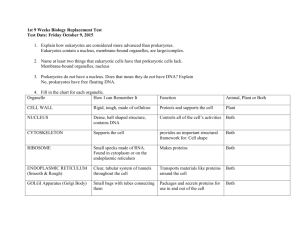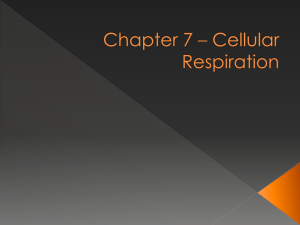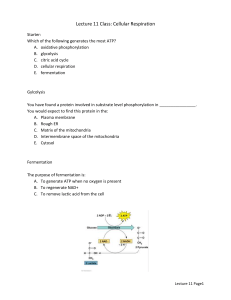KEY
advertisement
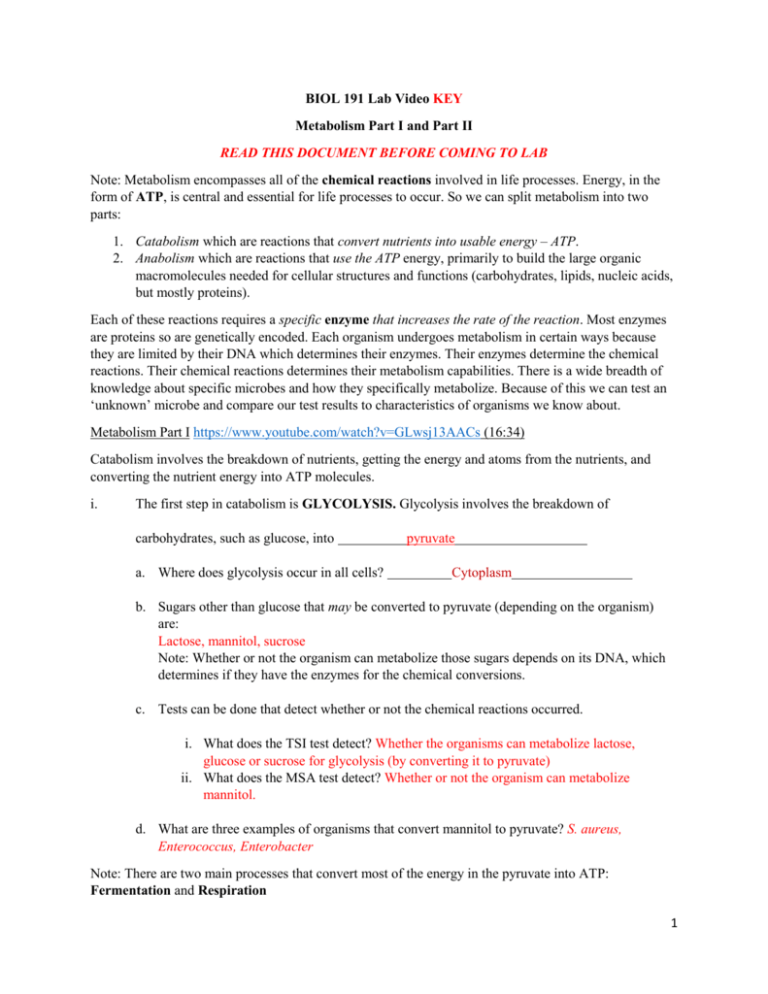
BIOL 191 Lab Video KEY Metabolism Part I and Part II READ THIS DOCUMENT BEFORE COMING TO LAB Note: Metabolism encompasses all of the chemical reactions involved in life processes. Energy, in the form of ATP, is central and essential for life processes to occur. So we can split metabolism into two parts: 1. Catabolism which are reactions that convert nutrients into usable energy – ATP. 2. Anabolism which are reactions that use the ATP energy, primarily to build the large organic macromolecules needed for cellular structures and functions (carbohydrates, lipids, nucleic acids, but mostly proteins). Each of these reactions requires a specific enzyme that increases the rate of the reaction. Most enzymes are proteins so are genetically encoded. Each organism undergoes metabolism in certain ways because they are limited by their DNA which determines their enzymes. Their enzymes determine the chemical reactions. Their chemical reactions determines their metabolism capabilities. There is a wide breadth of knowledge about specific microbes and how they specifically metabolize. Because of this we can test an ‘unknown’ microbe and compare our test results to characteristics of organisms we know about. Metabolism Part I https://www.youtube.com/watch?v=GLwsj13AACs (16:34) Catabolism involves the breakdown of nutrients, getting the energy and atoms from the nutrients, and converting the nutrient energy into ATP molecules. i. The first step in catabolism is GLYCOLYSIS. Glycolysis involves the breakdown of carbohydrates, such as glucose, into a. Where does glycolysis occur in all cells? pyruvate Cytoplasm b. Sugars other than glucose that may be converted to pyruvate (depending on the organism) are: Lactose, mannitol, sucrose Note: Whether or not the organism can metabolize those sugars depends on its DNA, which determines if they have the enzymes for the chemical conversions. c. Tests can be done that detect whether or not the chemical reactions occurred. i. What does the TSI test detect? Whether the organisms can metabolize lactose, glucose or sucrose for glycolysis (by converting it to pyruvate) ii. What does the MSA test detect? Whether or not the organism can metabolize mannitol. d. What are three examples of organisms that convert mannitol to pyruvate? S. aureus, Enterococcus, Enterobacter Note: There are two main processes that convert most of the energy in the pyruvate into ATP: Fermentation and Respiration 1 ii. FERMENTATION. During fermentation, pyruvate will then be broken down further. No oxygen is used during fermentation and it does not involve an electron transport chain like as respiration does. If an organism can ferment a specific reactant, such as lactose, (because they have the correct enzymes), characteristic end-products or by-products can often be detected. a. What are four common end-products of fermentation? What species produce these endproducts? i. Lactic acid: Lactobacillus bacteria, Homo sapiens ii. Ethanol: Saccharomyces, Candida fungi iii. 2,3 butanediol: Enterobacter iv. Mixed acids: E. coli b. Enzymes end-products are made. that the bacteria have will determine which fermentative c. What does the MR (methyl red) of the MRVP test determine? Mixed acid production during fermentation d. What does the VP (Voges-Proskauer) of the MRVP test determine? 2,3 butanediol production during fermentation Note: Fermentation only produces a few ATPs (2). More are produced if the organism undergoes respiration (see next). iii. RESPIRATION. Respiration is not fermentation. It requires additional enzymes and chemical reactions. These occur during the Krebs cycle and an electron transport chain. Respiration may include oxygen or some other molecule that takes its place. Fermentation does not have a Krebs cycle or an electron transport chain a. If the pyruvate is converted to acetyl CoEnzyme A (acetyl CoA), it may proceed to the Krebs cycle. Note: The Krebs cycle is a series of reactions where each product becomes the reactant in the next reaction, until the final product is one of the first reactants. b. During the Krebs cycle, CO2 is produced so you may see the production of gas . c. Nutrients other than carbohydrates, such as fats and proteins, may be metabolized to produce ATP. 2 i. Fats are made of: glycerol and fatty acids 1. The glycerol may enter glycolysis and be converted to pyruvate. 2. Fatty acids may be converted to acetyl CoA be further metabolized from there. ii. Proteins can be broken down into amino acids , some of which, after chemical conversions, can be metabolized in glycolysis or the Krebs cycle. But first the amino acids must be deaminated (NH2 removed) which creates ammonia (NH3 or NH4+), a toxic by-product. 1. The amino acid tryptophan can enter glycolysis and, therefore, converted into pyruvate. A by-product of tryptophan conversion is indole , which is detected by the indole test. 2. Cysteine can be converted directly into a Krebs cycle reactant. This conversion produces a sulfur by-product which can be detected. 3. Note: In some organisms (humans included), toxic ammonia is produced and converted into a nontoxic waste product, urea. Some bacterial species, such as Proteus can produce the enzyme urease which breaks urea down for further use and releases ammonia. Ammonia raises the pH which can be detected. iv. During the Krebs cycle, electrons are ‘collected’. They are passed from one electron carrier molecule to another to make more ATPs in the electron transport chain. Note: During some of the reactions of glycolysis and the Krebs cycle, electrons are pulled from the reactants during the chemical reactions. These electrons feed into the electron transport chain where most of the ATP is produced. Metabolism Part 2 https://www.youtube.com/watch?v=w4aPHjrMByY (3:04) Electron transport chain continued. i. During the electron transport chain, the electrons from the Krebs cycle (note: and glycolysis) are passed from one molecule to another (note: these are called electron carriers- the video calls them electron ‘magnets’), each with a higher electronegativity . This is the 3 relative strength of the attraction a molecule has for an electron. Note: Each successive carrier molecule that picks up an electron has a greater electronegativity than the previous carrier, and, therefore, a greater ‘pull’ on the electron. ii. The electrons flow down the chain toward the final electron acceptor (which has the highest ‘pull’ in the chain). What are three examples of final electron acceptors? oxygen (aerobic respiration) nitrogen and sulfur (anaerobic respiration) iii. As the electrons are passed, they release energy iv. This energy is used by the enzyme . ATP synthase This enzyme catalyzes the reaction that makes ‘lots’ of ATP. ATP synthase Note: ADP + phosphate ATP Note: At peak efficiency, the complete breakdown of glucose during glycolysis and aerobic respiration produces 38 ATPs in prokaryotes and 36 ATPs in eukaryotes. This ATP can then be used for anabolic process (such as synthesizing proteins). 4
